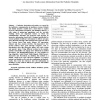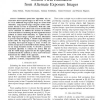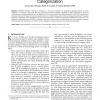PERCOM
2011
ACM
13 years 2 months ago
2011
ACM
—The emergence of personal mobile device with low cost sensors, such as accelerometer and digital compass, has made dead-reckoning (DR) an attractive choice for indoor pedestrian...
PERCOM
2011
ACM
13 years 2 months ago
2011
ACM
Abstract—The adaptive ubiquitous services, which dynamically adapt behaviors to requirements and contexts, are one of the major challenges in the ubiquitous computing. To facilit...
PAMI
2011
13 years 2 months ago
2011
—Traditional optical flow algorithms rely on consecutive short-exposed images. In this work, we make use of an additional long-exposed image for motion field estimation. Long-e...
PAMI
2011
13 years 2 months ago
2011
—CENTRIST (CENsus TRansform hISTogram), a new visual descriptor for recognizing topological places or scene categories, is introduced in this paper. We show that place and scene ...
PAMI
2011
13 years 2 months ago
2011
In this paper we address the problem of tracking an object in a video given its location in the first frame and no other information. Recently, a class of tracking techniques cal...
PAMI
2011
13 years 2 months ago
2011
Abstract—In this paper, we define meta-recognition, a performance prediction method for recognition algorithms, and examine the theoretical basis for its post-recognition score ...
PAMI
2011
13 years 2 months ago
2011
— This paper addresses how to model and correct image blur that arises when a camera undergoes ego motion while observing a distant scene. In particular, we discuss how the blurr...
PAMI
2011
13 years 2 months ago
2011
—In the research of computer vision and machine perception, three-dimensional objects are usually represented by 2-manifold triangular meshes M. In this paper, we present practic...
PAMI
2011
13 years 2 months ago
2011
—We present a discriminative part-based approach for human action recognition from video sequences using motion features. Our model is based on the recently proposed hidden condi...



